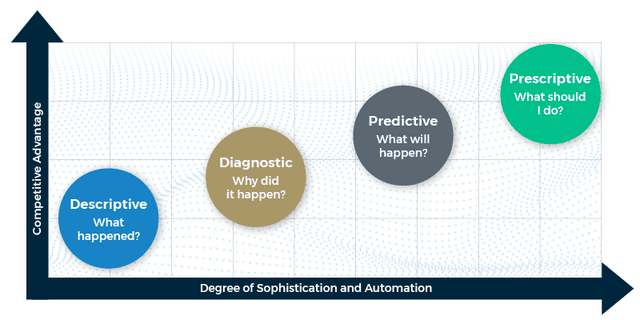
What Is Descriptive Analytics?

Descriptive analytics help people answer the question of “What happened?” by drawing conclusions from large, raw datasets. The findings are then visualized into accessible line graphs, tables, pie and bar charts, and generated narratives. Descriptive analytics is one piece of the larger analytics process that includes predictive and prescriptive analytics. By offering a holistic view of performance and trends, such as year-over-year sales growth or number of clients, descriptive analytics enables businesses to identify areas of strength and weakness to guide decisions and strategy.
Why Is Descriptive Analytics Important?
An annual report, workflow, and inventory all have one thing in common — descriptive analytics. Through sophisticated methods such as clustering, regression, suppression, and summary statistics, descriptive analytics enables people to break down large volumes of data to reveal trends,patterns, and insights. With this information, a business can see how key metrics have changed over time, which
helps find new opportunities for growth.
How Descriptive Analytics Works
Descriptive analytics is a vital part of any business regardless of industry and usually includes the following:
- Creating metrics to evaluate against KPIs
- Identifying and extracting the right data to measure against those KPIs
- Preparing data to ensure accuracy
- Using methods such as clustering, regression, suppression, and summary
statistics to find patterns and measure performance - Generating charts, tables, and graphs so findings are easy to understand
With descriptive analytics, a business can examine social media engagement including likes, comments, views, and followers; report on general trends; compare and analyze survey results; and outline past events such as marketing campaigns and sales.
Getting Started with Descriptive Analytics
Alteryx uses time intelligence, data mining and profiling, spatial and demographic analysis, and other methods to provide a strong foundation for analysis.
Alteryx allows users to:
- Handle large volumes of data with database-optimized queries, push-down processing, and in-database support
- Uncover insights, patterns, and trends with complete data profiling, easy data mining, and the ability to leverage data mining assets
- Enrich data with geocoding, demographic analysis, and third-party enrichment
- Import and clean, prep, and blend data from many different sources, plus export findings from analysis
Next Term
Data GovernanceRelated Resources
Customer Story
Protected: Saving Over 75 Hours Day with Automated Forecasting
- Data Prep and Analytics
- Data Science and Machine Learning
- Process Automation
Customer Story
Protected: Nippon Caterpillar Japan Streamlines Analysis Operations
- Data Prep and Analytics
- Marketing
- APAC